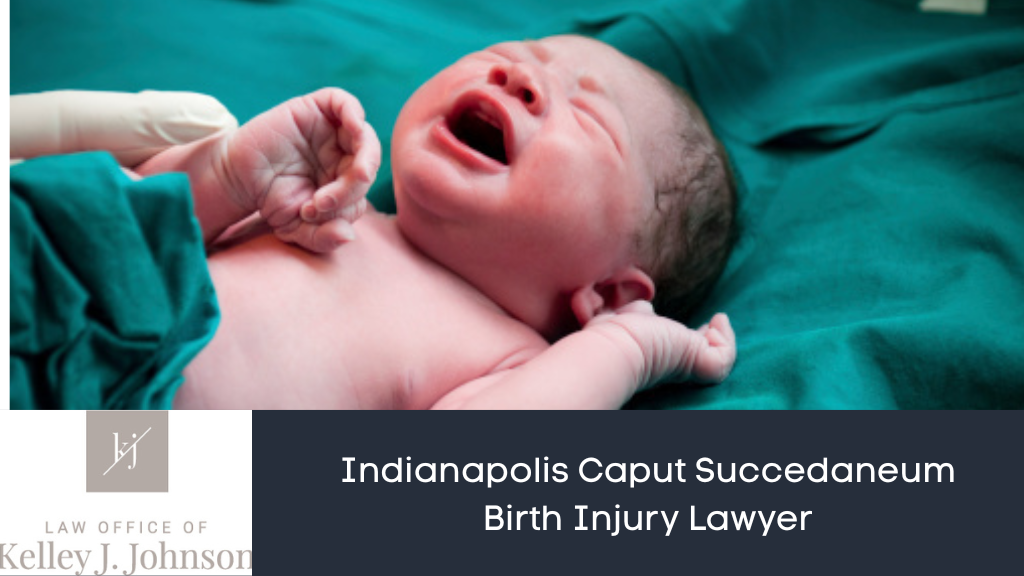
A baby’s skull isn’t fully formed when it’s born, and it can swell and form a cone shape during prolonged labor or when doctors use specific tools to assist a birth. While this condition (called caput succedaneum) often fades within a few days, it sometimes indicates more severe, long-term medical problems. In many cases, careless doctors or other doctors bear the blame for these birth injuries.
If your child suffered complications from caput succedaneum, the Law Office of Kelley J. Johnson is prepared to assist you. Our firm focuses exclusively on medical malpractice cases (including birth injury claims), giving us deep experience in holding healthcare providers accountable. We understand the nuances of these cases, including the role of the Indiana Medical Malpractice Act and the state’s Patient’s Compensation Fund. An experienced birth injury attorney from our law firm can gather evidence to support your claim, handle all the legal procedures, and fight to hold a careless doctor or healthcare facility accountable when serious birth injuries occur.
Let us help you pursue fair compensation for your child’s birth injury. Call now or complete our contact form for a free consultation with a member of our legal team.
What Is Caput Succedaneum?
Caput succedaneum is a condition that affects newborns. It causes noticeable swelling on the top of the baby’s head shortly after birth. This swelling usually happens due to pressure on the baby’s scalp during a difficult or long delivery—especially in long labors or when doctors use a vacuum extractor to assist the birth. The pressure on the soft tissues of the scalp against the cervix or birth canal can cause fluid to build up under the skin. The result is a soft, puffy bump that’s usually most noticeable right after delivery.
Caput succedaneum is one of the more common birth injuries and is usually not serious. In most cases, the swelling goes down within a few days without treatment. However, the swelling can be more severe in certain situations or lead to additional problems. If medical providers don’t recognize the condition or manage it properly, it may increase the risk of jaundice, infections, or birth trauma to the newborn’s skull. Additionally, caput succedaneum is an indicator that the birth may have been difficult. As a result, caregivers should be on the lookout for complications, such as brain injury due to oxygen deprivation.
How a Caput Succedaneum Lawyer Can Help
Caput succedaneum birth injury cases require robust medical evidence and a deep understanding of Indiana’s complex medical malpractice process. Without proper guidance from a caput succedaneum attorney, you may struggle to prove that medical errors caused or worsened your child’s birth injury. Meanwhile, your infant may need costly, long-term treatments for issues like neurological damage, physical therapy, or developmental support. A birth injury lawyer can handle the legal process so you can focus on your child’s health.
An experienced firm like the Law Office of Kelley J. Johnson can help you pursue fair compensation by:
- Reviewing your child’s medical records to identify what went wrong and whether medical professionals failed to act appropriately during labor or delivery
- Consulting medical experts to support your claim and explain how negligence may have contributed to your child’s injury
- Filing a complaint with the Indiana Department of Insurance, which is the required first step under Indiana’s Medical Malpractice Act
- Guiding you through the medical review panel process, where three physicians examine your claim before you’re allowed to proceed to court, a step is unique to Indiana
- Helping you meet strict deadlines, such as the standard two-year limit for filing malpractice lawsuits (The deadline extends to a child’s eighth birthday for children under six.)
- Seeking compensation through both the negligent doctor’s insurance (which covers the first $500,000) and the Indiana Patient’s Compensation Fund, which can provide up to $1.3 million more in compensation
- Building a case for full compensation
With our help, your birth injury lawsuit could include compensation for:
- Your child’s current medical care and future medical expenses
- Lost income from time off work, taking your child to medical appointments, etc.
- Your child’s reduced future earning capacity due to brain damage or other complications
- Your child’s pain and suffering
- Your and your child’s emotional distress
- A decrease in your child’s quality of life
Common Causes of Caput Succedaneum
Many caput succedaneum birth injuries happen due to negligence by doctors, other healthcare providers, or healthcare facilities. Common causes include:
- Prolonged or difficult labor – If medical staff fail to monitor labor progress or delay necessary interventions (like C-sections), prolonged pressure on the baby’s scalp can cause excessive swelling that leads to caput succedaneum.
- Improper use of vacuum extractors – Using too much force or placing a vacuum incorrectly on a baby’s head can significantly increase the risk of scalp trauma.
- Premature rupture of membranes – When the protective amniotic sac breaks too early and the baby is not promptly delivered, it can lead to increased pressure on the scalp. Delayed action by healthcare providers may qualify as negligence.
- Failure to monitor fetal positioning – If doctors don’t recognize that the baby is in a position that increases pressure on the head during birth, they may miss the opportunity to take safer delivery measures.
- Inadequate staffing or supervision – Poor communication or understaffing in labor and delivery units can delay responses to signs of fetal distress or complications during birth.
Indiana birth injury attorneys can investigate your case to determine the cause of your baby’s birth injury and work to hold the negligent medical professionals responsible.
When Is Caput Succedaneum a Sign of Medical Negligence?
Experienced birth injury lawyers know that caput succedaneum is often a sign of medical negligence when the condition is unusually severe or leads to complications that your doctor could have prevented with proper care. To prove that negligence occurred, you and your lawyer must show that a healthcare provider failed to meet the “applicable medical standard of care.” This standard refers to the level of attention and skill that a reasonably careful medical professional would have used under similar circumstances.
For example, if a doctor used excessive force with a vacuum extractor, ignored signs of fetal oxygen deprivation during labor, or failed to monitor the baby after birth, those actions—or inactions—could fall below the accepted standard of care. Your attorney will need to demonstrate that this failure directly caused or worsened your child’s injury.
Proving negligence in medical malpractice cases requires expert testimony, thorough medical records, and a strong understanding of both medical and legal procedures. With experienced legal help, families may be able to hold negligent medical providers accountable for preventable birth injuries.
Contact an Indianapolis Caput Succedaneum Birth Injury Lawyer
Attorney Kelley J. Johnson and her team have the experience, resources, and tenacity to help you and your child recover fair compensation for a caput succedaneum birth injury. Call the Law Office of Kelley J. Johnson now or complete our contact form for a free consultation.









